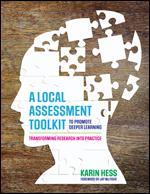Welcome to the Companion Website
- Tool 1: Cognitive Rigor Matrix (Reading)
- Tool 2: Cognitive Rigor Matrix (Math-Science)
- Tool 3: Cognitive Rigor Matrix (Writing/Speaking)
- Tool 4: Cognitive Rigor Matrix (Social Studies/Humanities)
- Tool 5A: Cognitive Rigor Matrix (Fine Arts)
- Tool 5B: Cognitive Rigor Matrix (Health and Physical Education)
- Tool 5C: Cognitive Rigor Matrix (World Language)
- Tool 5D: Cognitive Rigor Matrix (Career and Technical Education)
- Kid Tool: I Can Rock the Rigor
- I Can Rock the Rigor: Kid Tool (Interactive)
- Kid Tool: Collaborative Inquiry Plan
- Kid Tool: The One-Pager
- Kid Tool: TBEAR- Planning for Discussion or Writing
- Kid Tool: TBEAR- Vocabulary Development (from Definitional to Conceptual)
- Kid Tool: Kid TBEAR
- Kid Tool: Multi-sensory Clustering
- Kid Tool: Sample Turn and Talk Frames
- Tool 6: Planning Worksheet- Analyzing Qualitative Features of Text Complexity for Instruction & Assessment
- Tool 6: Planning Worksheet- Analyzing Qualitative Features of Text Complexity for Instruction & Assessment (Interactive)
- Tool 7: Gradients in Complexity- Text Complexity Rubric for Informational Texts
- Tool 7: Gradients in Complexity- Text Complexity Rubric for Informational Texts (Interactive)
- Tool 8: Gradients in Complexity- Text Complexity Rubric for Literary Texts
- Tool 8: Gradients in Complexity- Text Complexity Rubric for Literary Texts (Interactive)
- Kid Tool: Writing Practice with Compare-Contract Structure
- 10 Increasingly Complex Text Structures
- Using Predetermined Assessment Targets: Grade 5 Literary Text
- Kid Tool: Word Splash
- Kid Tool: As-You-Read Bookmark Assessment
- Kid Tool: Card Pyramid-Planning for Writing a Summary or Precis
- Kid Tool: Response to Text with Strategy Use
- Tool 9: Task Quality Validation Protocol: Purpose, Alignment, Engagement and Fairness
- Tool 9: Task Quality Validation Protocol: Purpose, Alignment, Engagement and Fairness (Interactive)
- Tool 10: Analyzing Formative Assessments Strategic Planning Tool
- Tool 10: Analyzing Formative Assessments Strategic Planning Tool (Interactive)
- Tool 11: Rubric Quality Review Worksheet
- Tool 11: Rubric Quality Review Worksheet (Interactive)
- Tool 12: Student Work Analysis: Analyzing and Acting on Evidence
- Tool 12: Student Work Analysis: Analyzing and Acting on Evidence (Interactive)
- Tool 13: What is the Evidence? Locating Examples in Student Work for Writing Annotations
- Tool 14: Individual Reviewer Rubric Score Sheet
- Tool 15: Team Rubric Score Sheet
- Tool 16A: Task Validation Summary
- Tool 16B: Task Validation Summary- In-Depth Feedback
- Tool 17: Cognitive Lab Part 2
- Tool 18: Cognitive Lab Part 3A
- Tool 19: Cognitive Lab Part 3B
- Tool 20: A Guide To Performance Assessment Development
- Tool 21: Performance Assessment Overview: Purpose And Use
- Kid Tool: Anatomy of an Opinion, Argument, or Critique
- Kid Tool: Anatomy of a Mathematical/Scientific Argument or Critique
- Examples of Grade 3 Student Work (DOK 3) for Analysis Using the Anatomy of an Opinion/Argument Templates
- Kid Tool: Introduction: Focus, Controlling Idea, or Thesis Statement—Respond to Prompt 1
- Kid Tool: Introduction: Focus, Controlling Idea, or Thesis Statement—Respond to Prompt 2
- Systematic Observation Documentation Template
- Kid Tool: My Writing Checklist—Opinion
- Kid Tool: My Writing Checklist—Narratives
- Kid Tool: My Writing Checklist—Informational
- Kid Tool: Formative Strategy 5: Anticipation Guides
- Kid Tool: Task Shell Example 2—Artifact Analysis
- Kid Tool: Task Shell Example 3—Informational Writing
- Kid Tool: Task Shell Example 4—Opinion Writing
- Kid Tool: Task Shell Example 5—Critique of Literary Texts: Character Study in a Self-Selected Text
- Kid Tool: Task Shell Example 6—Analyzing Literary Texts—Character Study
- Kid Tool: Task Shell Example 7—Analyzing Literary Texts—Character Study: Comparing Characters
- Kid Tool: Task Shell Example 11—Giants of Science
- Kid Tool: Task Shell Example 12—Scientific Inquiry
- Scientific Inquiry: Experimental Approval Form
- Kid Tool: Task Shell Example 13—The Novel
- Kid Tool: Task Shell Example 14—Turning Points in History
- Tool 22: Analyzing Learner Characteristics/Student Work Samples Along a Progression
- Tool 23: Guiding Questions For Developing, Refining, Or Validating Learning Progressions
- Tool 24: Planning Instruction Using A Learning Progressions Mindset
- Tool 25: Unit Planning Template: Using Learning Progressions To Guide Formative, Interim, Or Summative Assessment
- Tool 25A: Sample Unit Planning Template: Using Learning Progressions To Guide Formative, Interim, Or Summative Assessment
- Tool 26: Looking For Rigor Walk-Through Tool: Teacher-Student Roles
- Kid Tool: My Favorite—or Not So Favorite—Holiday
- Kid Tool: Investigating Sharks
- Kid Tool: My Note Facts About…
- Tool 27: Year-At-A-Glance: Planning Classroom- Based Assessments Over The School Year
- Tool 27: Year-At-A-Glance: Planning Classroom- Based Assessments Over The School Year (sample)
- Tool 28: Discussion Questions: Examining Our Local Assessment System
- Tool 29: Basic Individual Test Blueprint Analysis Worksheet
- Tool 29: Basic Individual Test Blueprint Analysis Worksheet (Explained)
- Tool 29: Basic Individual Test Blueprint Analysis Worksheet (Example)
- Tool 30: Assessment System Blueprint—Mapping Content Standards Or Proficiencies To Assessments
- Tool 30: Assessment System Blueprint—Mapping Content Standards Or Proficiencies To Assessments (Sample 1)
- Tool 30: Assessment System Blueprint—Mapping Content Standards Or Proficiencies To Assessments (Sample 2)
- Tool 31: Advanced Individual Test Blueprint Analysis Worksheets: One-Way Alignment, With Additional Factors To Consider
- Tool 32: Text Complexity Analyses Summary
- Tool 33: Item Or Task Bank Review

